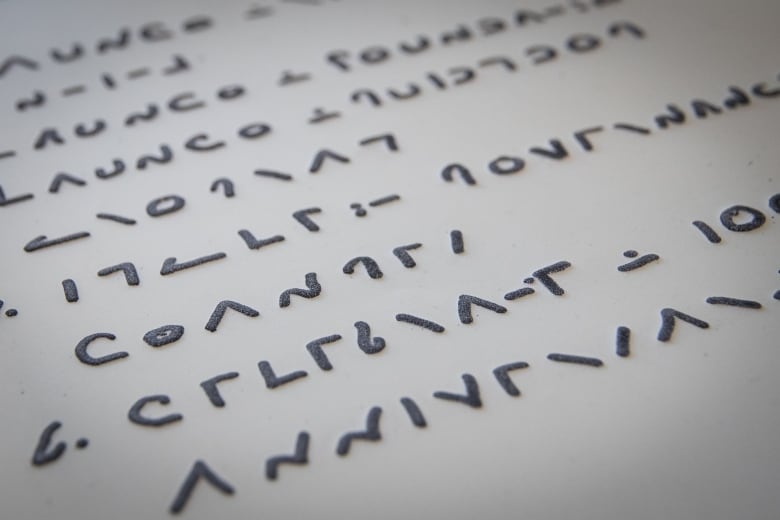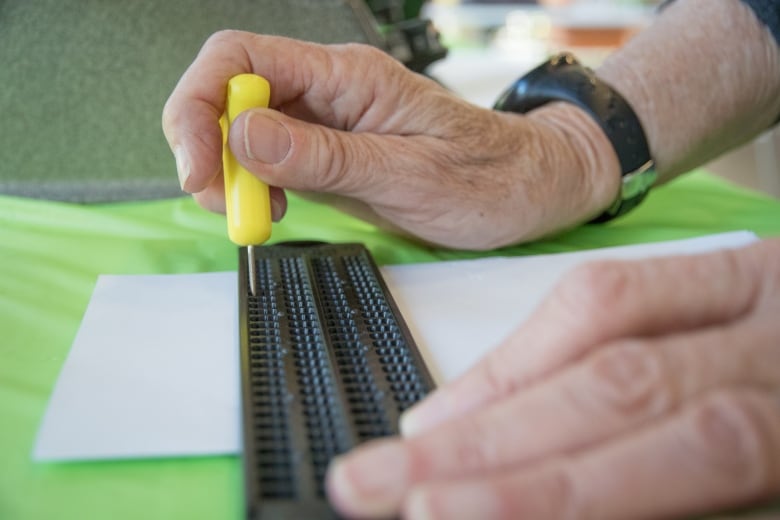How braille, screen readers and other technology changed the world for blind readers
CNIB exhibit chronicles the evolution of technology for blind readers in the past 150 years

Thick fingers of smoke from the burning Imo beckoned to those who had heard the ship crash into the Mont-Blanc in Halifax harbour.
Many on shore pressed their faces to their windows, moments before an explosion sent glass and debris flying for more than two kilometres — blinding at least 37 people and partially blinding at least 217 others, according to archival records.
The devastation 100 years ago, which also killed 2,000 people, prompted an outpouring of funding from across North America to help teach those who had been blinded suddenly to learn to function without sight.
And the Halifax School for the Blind, which had previously only taught children, opened its doors to the victims of both the explosion and the veterans returning without sight after the First World War.
As part of the Halifax Explosion centennial, the Canadian National Institute for the Blind has released an exhibit chronicling the inventions that changed blind literacy.
It begins with the man who invented braille.

Braille vs. Moon type
Louis Braille lost his sight as a toddler following an accident in his father's workshop. He's been described as having a fierce determination to learn to read; when Braille learned of the code that French soldiers were using in the Napoleonic war, he adapted it for himself.
A more sophisticated version of the original code, braille is made up of six dots that are raised or absent to indicate which letter of the Roman alphabet they represent. Braille first published the system in 1829.
"It eventually became the international standard and is used widely, even today," says Jane Beaumont, the volunteer archivist at CNIB. "But before braille became the standard there was quite a fight — we call it the battle of the formats."

The battle was also a cultural one.
William Moon developed his own version of raised text in the 1840s after he went blind himself. Unlike Louis Braille, Moon lost his sight in his 20s — and supporters of his writing system argued that it was easier for adults to grasp than braille. It more closely resembles the letters of the alphabet.
And in 1877, the Halifax School for the Blind started teaching it, Beaumont says.
- How the largest mass-blinding in Canadian history birthed CNIB
- Thanks to special glasses, a legally-blind teen can see — and shoot 3s with the Harlem Globetrotters
There are different theories about why the French code won out. But Beaumont says it's likely because braille spread more quickly.
"It was already in several countries and, if you think about it, it's actually language independent," she says. "Any language that uses the Roman alphabet can adopt braille, whereas Moon was much more localized."
Seeing through your fingertips
While braille relies on a person's fingertips to see letters, teachers use the same concept to help their students visualize images. A thermal printer can create the raised lines of a dog's body, filling in the centre with another texture.
That combined with sitting next to the animal to feel its fur, to run one's hand along it to get its shape, help children to identify objects or with mapping geography.

"So they're learning both shapes and words," Beaumont says, outlining first an apple with the pad of her finger before dragging it across the raised dots beneath spelling out the word: a-p-p-l-e.
"It's exactly the same as other children's books."
Software and screenreaders
At seven, it took Robert Ganong less than a year to fluently read braille. He had very limited vision and moved to the Halifax School for the Blind in order to learn a new way to communicate.
And roughly five decades later, he contends the writing system remains a critical tool for children even as other adaptive technology like screen readers, Siri and other voice-recognition software emerge.
- Hope amid the rubble: How the disastrous Halifax Explosion sparked reform
- Blind Canadians guided by beacon technology
"With braille you actually have your fingers on the letters and written words so it really is helpful and practical in terms of spelling and actually recognizing what words look like," he says.

But Ganong says those technologies are critical to finding work — particularly software that will read a computer screen and accept audio commands for navigating the internet, email and word processors.
"Braille is great and kind of gives a blind person a connection to that literacy benchmark, but it's the modern technologies that I think will carry a person to successful higher levels of education and employment."
The CNIB exhibit lives online and will remain on display at the Halifax Central Library until Oct. 16.
The exhibit also celebrates a new partnership between the province's libraries and the Centre for Equitable Library Access. The agreement will allow those with vision or print disabilities to access more than 400,000 publications in braille, audio or other formats for people with print disabilities.


